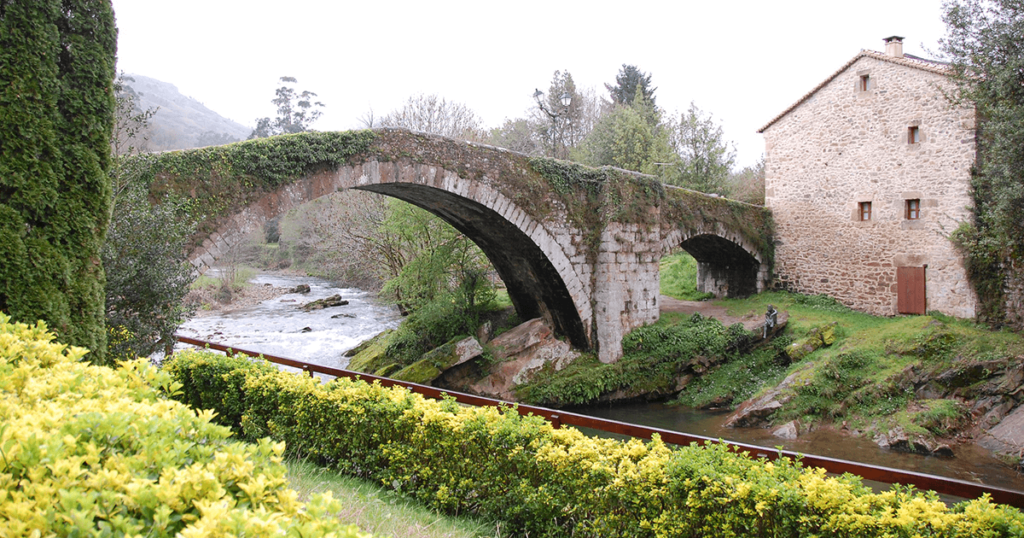
Liérganes is a beautiful Cantabrian village, half an hour inland from Santander and about two hours east of where I live in Gijón. I’d never heard of it until the last Sunday in August, when a race called La Subida a las Tetas de Liérganes took me there. I went with my running partner, who was as ignorant of the village as I. Before we left home, we found it on the Internet, and yes, there they were, the tetas we would run up to, a pair of green peaks with rocky tips, just above the village.
The race was seven kilometers up a narrow road to the col between the two peaks, and the day was perfect for a run, cloudy and cool as we gathered at the edge of the village, still no wind and no rain, but with clouds darkening and a forecast of water, agua. My partner looked at the gathering runners. “There goes the winner,” he predicted. I saw a nice-looking man, slim, with gray in his dark curly hair. “Who is it?” I asked, and learned that he was an athlete of international standing, a celebrity. I watched him in the milling group, and when I caught his eye, he smiled and nodded, as if he recognized me. In a way, he did: I was an admirer.
The run was very pretty, past meadows, houses, trees, outcroppings of rock, some cows, berry-laden brambles. At the top was water and a sandwich. Plus the view back down to the village, with its old stone buildings, walled gardens, and beautiful arched bridge across the river, seeming a stone’s throw away. “You must visit the old town before you go,” a local runner told us. In particular, he said, look for the statue of the fish-man, el hombre pez, under the Roman bridge.
The legend of the fish-man dates from the 17th century, when a local family sent a son off to Bilbao to apprentice as a carpenter. While swimming in the estuary there one morning, the young man was carried away by the currents and presumed drowned. Five years later, in the port of Cádiz in the south of Spain, two fishermen pulled from their nets a strange creature, man-like but with pale scaly skin and something like gills on his neck. He had skimpy red hair, and the only word he said was Liérganes, which clarified nothing for his captors until a sailor in the port said he knew it to be the name of a village near his hometown of Santander.
The fish-man was taken north, and when freed on nearing the town, he led the way directly to the home of the family who had lost their son in Bilbao. The old mother recognized him, and for nine years he lived there, usually going naked and barefoot, doing simple tasks, and saying occasionally the words tobacco, bread, and wine. One day he went for a swim in the sea and was never heard from again.
The writer who made the story famous some decades afterward and argued for its veracity was Friar Benito Feijóo, a scholar and educator with a reputation for rigorously rooting out superstition and ignorance. It seemed unlikely to later students of the case that Feijóo would have backed the story without having good reason to do so, so it couldn’t be pure fabulation. But how could it be true? It was a mystery, one that got a lot of attention. Gregorio Marañón, a doctor writing about the case two centuries later, suggested cretinism as the explanation. Cretinism, now called hypothyroidism, was common in that era in the villages of Cantabria; the afflicted had both physical and mental symptoms from the lack of iodine—pale, scaly skin and developmental disabilities—that recall attributes of the fish-man. Marañón surmised that the afflicted man wandered off to reappear years later in Cádiz, remembering only the name of his village. Out of that had grown the legend.
After visiting the statue of the fish-man, my running partner and I crossed back over the bridge. A sign noted that this bridge, one of a triad on the river, was not Roman but built in the late 16th century to replace an earlier one. From the far side we gazed up again at las Tetas de Liérganes. The runner we’d expected to win the race, a man as fast as a greyhound, was not first across the finish line, nor second, nor third. Of course not. He wasn’t there to compete but commissioned to lend his presence to local stars. “What’s his name again?” I asked. Fabián Roncero, a runner of World Championship fame and holder of records, had hardly broken a sweat that morning. He’d relaxed at the top of the peaks that are made of rock and not flesh and are nowhere near as soft as they appear.
Hills posturing as breasts, a village much farther than a stone’s throw, a Roman bridge from the 16th century, and a legend about a fish-man who might simply have been a sick man. I was not disappointed, not in the least: I had raced with Fabián Roncero, and the day, despite expectations, did not deliver the threatened rain. Next time I see Fabián, I’ll catch his eye: Remember me? Remember that day, perfect, from start to finish?


